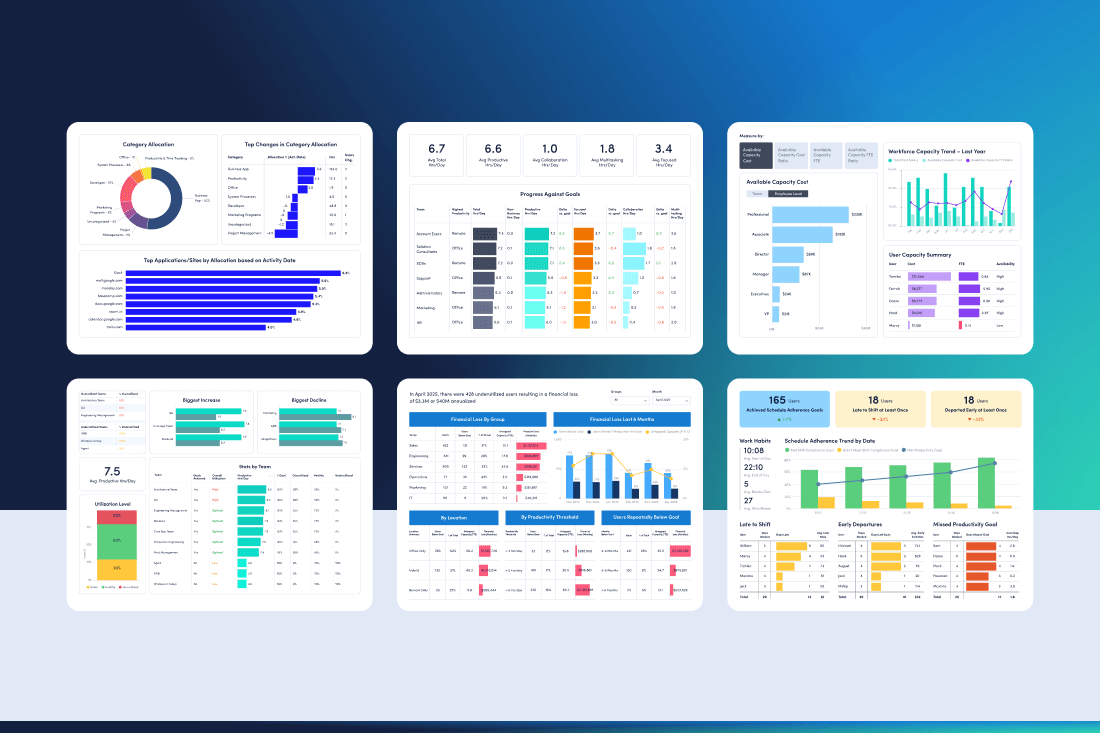Ever wondered why some teams effortlessly hit goals while others struggle to keep up? The answer comes down to staff productivity. No, we’re not talking about working longer hours or pushing harder. Improved productivity means understanding what makes your team tick and removing the obstacles slowing them down.
Let’s break down what staff productivity is, what it really means and how you can help your team work smarter.
What is staff productivity?
Staff productivity is a measure of how efficiently your employees get work done and help your company reach goals. Instead of focusing on how many hours people work, staff productivity looks at the quality of work itself — and the amount of time it takes to complete high-value tasks.
For example, think of the staffer who creates an important spreadsheet in a two-hour block of focus time. That team member is much more productive than the employee who completes the same task in eight hours in between Slack chats, extraneous meetings and other distractions.
Key factors influencing staff productivity
Every manager and business leader knows the real path to profitability lies in making teams as productive as possible. But unfortunately, the digital nature of many jobs means most employees face roadblocks daily. Key factors influencing workplace productivity include:
- Company culture: A conducive work environment that promotes collaboration and creativity significantly enhances productivity levels.
- Employee engagement: Employees who feel valued and engaged are more likely to be motivated and committed to their work.
- Technology: Access to the right tools and technology streamlines processes and reduces time spent on mundane tasks.
- Time management: Employees who know how to schedule tasks and limit distractions tend to deliver better results in less time compared to staffers with poor time management skills.
- Role alignment: Properly matching individual employees to responsibilities based on skills and strengths directly impacts productivity.
- Workload balance: Too much work leads to burnout and disengagement, while too little work negatively impacts motivation.
- Communication: A lack of clarity on assignments makes it difficult to move projects forward. Regular communication equips staffers with the information needed to stay on task.
- Training and development: As employees develop new skills, and as they become more proficient on tools and technology, productivity goes up.
Why staff productivity matters
The benefits of productivity can’t be overstated. Organizations that prioritize it are better positioned to adapt, innovate and meet changing customer demands. High levels of staff productivity allow you to:
Improve profitability
One of the most direct benefits of high staff productivity is its positive impact on profitability. Productive employees produce more in less time, effectively reducing your operational costs. This increased output leads to higher revenues, allowing businesses to reinvest in growth initiatives.
Increase customer satisfaction
Workforce productivity enhances the quality of your products and services, leading to increased customer satisfaction and loyalty. Satisfied customers are more likely to return and recommend the business to others, further driving profitability.
Invest in the right technology
Investing in the right technology empowers staff to work more efficiently and focus on higher-value activities. For example, project management tools reduce the likelihood of delays and errors by helping teams stay organized and prioritize assignments.
Enhance engagement
When your team is productive, staff feel accomplished and valued. This creates a positive cycle where engaged employees naturally work more efficiently, leading to productive teams with clear goals, better workflows and more time for meaningful work.
Boost retention
Nobody wants to work in a chaotic or inefficient environment. When you improve productivity, you’re creating a better employee experience and improving job satisfaction. Employees stay longer when they feel supported and see their contributions making a real difference.
Promote innovation
Improved productivity frees up mental space and time for creative thinking. When your team isn’t constantly putting out fires, they focus on solving bigger problems and coming up with new ideas. Productive workplaces naturally become more innovative because people have the bandwidth to think beyond just getting through daily tasks.
How low staff productivity hurts businesses
Low productivity impacts your business in tangible ways. For starters, disengaged employees cost companies around the world an astounding $8.8 trillion in lost productivity. Factor in the nearly three hours a day spent on unproductive tasks, and the $100 million a year that goes to unnecessary meetings, and you’re looking at significant expenses.
These productivity losses create a domino effect touching every aspect of business:
- Increased labor costs as you hire more employees or add overtime hours to complete the same amount of work that engaged teams could handle efficiently.
- Lower customer satisfaction as projects are delayed, quality suffers and response times slow.
- Less innovation from teams that lack the focus and energy to pursue creative solutions or process improvements.
- High turnover as high-performing employees become frustrated with the sluggish pace and seek opportunities elsewhere.
4 steps to improve staff productivity
If the above stats seem daunting, we have good news. Improving employee productivity isn’t just a possibility. With the right insights, it’s possible to make significant gains within weeks or months. In fact, it’s not uncommon for ActivTrak customers to save $1 million or more — just by boosting labor productivity.
Not sure where to start? Try these strategies.
1. Assess current staff productivity levels
You can’t improve what you don’t measure, so start by getting a clear picture of how your team actually spends their time. Use workforce analytics to see exactly where productivity gaps exist — maybe your marketing team spends too much time in email, or your developers face more interruptions than they realize. This baseline gives you real data to work with instead of making assumptions about what needs fixing.
2. Remove bottlenecks and inefficiencies
Now that you know where the friction is, the next step is tackling it head-on. Look for those frustrating workflow hiccups that make simple tasks take forever — like waiting for approvals you could automate or switching between too many different tools. Spotting these productivity drains allows you to create a smoother process and empower your team to focus on work that actually moves the needle.
3. Balance staff workloads
Nobody does their best work when they’re overwhelmed or bored. Use productivity data to see who’s consistently maxed out and who might have bandwidth for additional projects. When you can distribute work based on actual capacity rather than guesswork, your team stays engaged without burning out — and that’s when you see the best results.
4. Monitor and refine policies
Think of productivity improvement like tending a garden — it needs regular attention to keep growing. Check on your metrics regularly to see what’s working and what isn’t. Is your new meeting policy actually helping? Have remote work patterns shifted since last quarter? Regularly review important metrics so you know when it’s time to adjust your approach and keep building on your wins.
Measure staff productivity with ActivTrak
Now that you know what staff productivity is (and why it’s important), it’s time to turn your productivity insights into action. ActivTrak provides the visibility you need to understand how work really gets done in your organization. Instead of guessing what’s slowing your team down, you’ll see exactly where time goes, which processes need streamlining and how small changes make a big difference.
The best part? You don’t need to be a data scientist to make sense of it all. Our intuitive dashboards and reports make it easy to spot productivity trends, celebrate wins and course-correct as needed. Request a demo to see how 9,500 organizations like yours use ActivTrak to create a more productive, engaged workplace where everyone does their best work.





